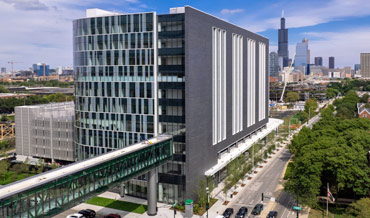A Chiari malformation is a structural defect in the cerebellum, the part of the brain that controls balance. It occurs when the space below the back of the skull is too small and brain tissue gets pushed down into the spinal canal.
Types of Chiari Malformation
- Chiari malformation type I: Because it often does not cause symptoms, type 1 (the most common type) is often discovered by accident while people are being treated for another condition. Most patients are in their mid- to late-30s at the time of diagnosis.
- Chiari malformation type II or Arnold-Chiari malformation: Typically accompanies myelomeningocele, a form of spina bifida in which the backbone and the spinal canal don’t close properly before birth. This form of Chiari malformation is usually diagnosed during pregnancy, right after birth or in early infancy.
- Chiari malformation type III: The most serious but rare form, type III is usually diagnosed during childhood. It can cause serious neurological defects and carries a higher risk of death than type I or type II.
Chiari Malformation Symptoms
Chiari malformation symptoms vary from person to person. And, each person’s symptoms can change over time depending on the amount of pressure on tissues and nerves.
Some people with Chiari malformation don’t have any symptoms. However, those who do almost always have at least five of the following symptoms:
- Headache that starts in the back of the head and spreads forward, brought on by coughing, sneezing, straining or other actions (the most common symptom)
- Balance problems
- Trouble swallowing (dysphagia) or speaking (common symptom in young children with Chiari malformation)
- Dizziness
- Extreme pain in the neck and shoulders
- Fatigue
- Loss of bladder and bowel control (common symptom in children)
- Nausea
- Numbness, weakness or other abnormal feelings in the arms or legs
- Poor hand coordination
- Tinnitus (ringing or buzzing in the ears)
- Sleep apnea (common in both adults and children with Chiari malformation)
- Scoliosis
- Vision problems, including nystagmus (rapid, involuntary movement of the eyes), blurred or double vision, and sensitivity to light
Chiari Malformation Treatment at Rush
Neurosurgeons at Rush have decades of expertise with Chiari malformation. They will work with you to develop a treatment plan based on your specific symptoms and the nature of your malformation.
There are typically three approaches to treating Chiari malformation:
- Watchful waiting: If you have no symptoms, only mild symptoms, or no definite diagnosis, the best option may be to wait and see if or how symptoms progress. Your doctor will monitor you for changes in your health, including new or worsening symptoms.
- Treat symptoms individually: Your doctor may recommend this approach in the following instances:
- Your symptoms are too disruptive to ignore but not severe enough to justify surgery
- You don’t want surgery or aren’t healthy enough to have surgery
- You have not received a definite diagnosis of Chiari malformation
- Surgery: Fewer than half of people diagnosed with Chiari malformation have surgery. Chiari malformation surgery is typically performed for the most severe forms of the condition.
Chiari Malformation Surgery at Rush
Surgery can reduce or stabilize symptoms and prevent the condition from worsening.
- Rush neurosurgeons perform posterior fossa decompression. The most common surgery for Chiari malformation, posterior fossa decompression relieves pressure in the area of the skull base where the spinal cord meets the brain.
- You may need other brain or spinal cord surgeries to relieve pressure on the spinal cord or make additional room for your brain. If so, your neurosurgeon will discuss the procedures with you.
Rush Excellence in Chiari Malformation Care
- Care tailored to your needs: Our neurosurgeons work with you to address the symptoms that are most worrisome to you. They also work closely with other Rush providers. If neurosurgery is not the best option for you, they will connect you to another Rush expert.
- Neurosurgical expertise: Rush neurosurgeons see a high volume of patients, among the highest in the Chicago area. This gives them experience with a wide variety of conditions. It also means our patients benefit from proven neurosurgical techniques.
- Nationally recognized expertise: Neurology and neurosurgery at Rush University Medical Center is consistently ranked among the best in the nation by U.S. News & World Report.



